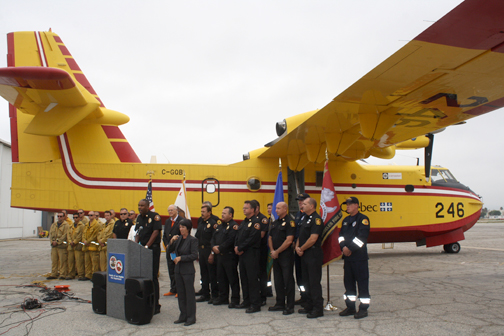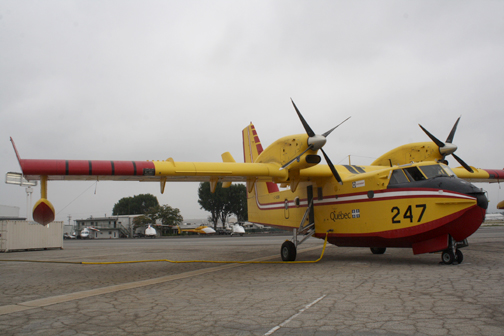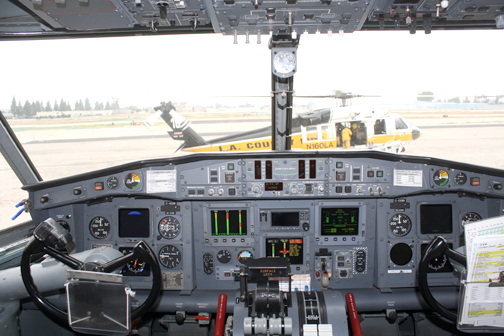
Los Angeles County Fire Chief Daryl Osby joined LA County Supervisor Michael Antonovich, Quebec Representative to LA Melissa Isom and LA Fire Chief Ralph Terrazas in welcoming the Super Scoopers from Quebec and Erickson Air-Crane as they prepare for the fire season.
Since arriving earlier this month, two Canadair Super Scoopers have already been put to work.
By Mary O’KEEFE
The Super Scoopers are here. Actually they arrived on Aug. 15 and were immediately in service helping fight the fires in Montebello, Castaic and Palos Verdes.
Last Friday water-dropping aircraft were the background for a press conference at the Van Nuys Airport. Two Canadair Super Scoopers and a helitanker were on display as officials talked about the importance of the water dropping aircraft.
The contracted aircraft are in addition to the nine that are already in the L.A. County Fire Dept. fleet.
“We currently have the Super Scooper and Helitanker … these are 90 day contracts that can be extended [if needed],” said L.A. Supervisor Michael Antonovich. “This is the 22nd year we have contracted with [the water-dropping aircraft].”
The long time relationship between L.A. County and Quebec began after a friend of Antonovich’s mentioned how much they were needed.

“My former professor and television [newsman] Hal Fishman loved to fly. He would always call me and say look at the Super Scooper, look what they are doing. We need them,” Antonovich said. “These Antonovich said. “These additional three [aircraft] enhance the nine [LACOFD] already have.”
The Super Scoopers can hold up to 1,600 gallons of water, which they can mix with foam.
“They take 12 seconds to scoop from a lake and are ready to fly in five minutes. They [can fly] for three hours before needing to refuel,” he added.
The Erickson Air-Crane helitanker can hold up to 2,200 gallons of water; it too can drop foam as well and can be ready from start-up to lift-off within eight minutes.
“Quebec is proud of the long standing relationship with [L.A. County],” said Melissa Isom, Quebec representative to L.A. “The [Super Scoopers] are supported by an experienced crew from Quebec.”
The CL 415 is specifically designed in Quebec to fight fires, explained Isom.
Crescenta Valley residents are well aware of the importance of water-dropping aircraft. Antonovich had voiced criticism of the U.S. Forest Service and its reluctance to call in water-dropping aircraft during the Station Fire in 2009. The fire spread quickly in rugged terrain, and it is believed that water drops may have quickened the knock-down of the wildfire that spread throughout the Angeles National Forest.
LACoFD Chief Daryl Osby spoke at the press conference of the importance of the partnership with Quebec.

“We are experiencing an unprecedented drought. This is the fourth year of an ongoing drought (below rainfall norms). The vegetation is dry and we predict that fires are going to be very extreme as evidenced by the fires in northern California, Oregon and Washington. Those fires have unfortunately also cost the lives of several firefighters,” Osby said.
He added that firefighters are concerned about dramatic wind events, like Santa Ana winds, in October and November before any rains are expected.
Water dropping aircraft are valuable, but not if they can’t get in the air.
“Our Super Scoopers cannot fly unless the skies are clear,” Osby said.
Drones are a real concern for firefighters on the ground and in the air.
“We are very concerned about [drones],” Capt. David Scanlan, captain air operations LACoFD, said in an interview with CVW. “They [firefighters] had to shut down the fire operations. It is a big concern.”
He added that typically the drones are operated by people who are using them recreationally. They want to get photos or video of the fire.
“Primarily as a first responder we are worried about our air space,” he said.
Osby advised anyone who owns a drone to visit the www.faa.gov to read the rules and regulations, but during a fire do not fly them at all.
